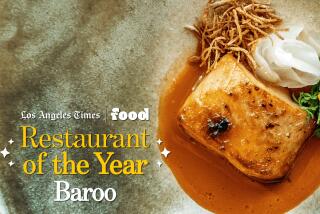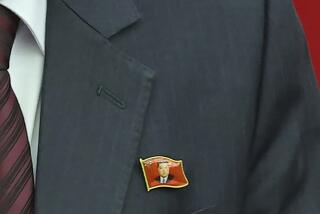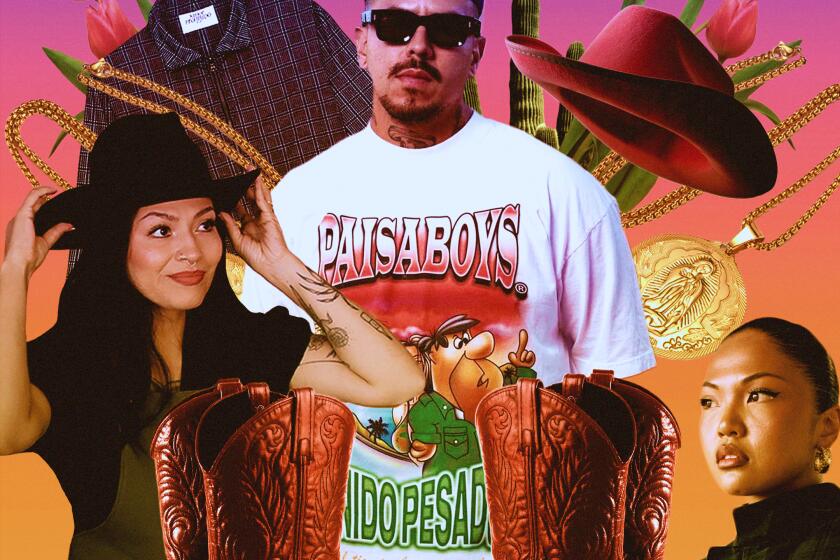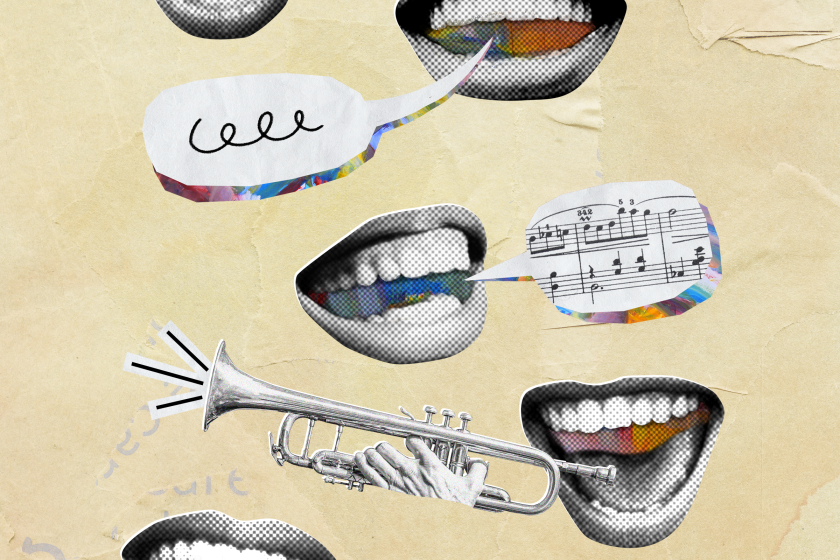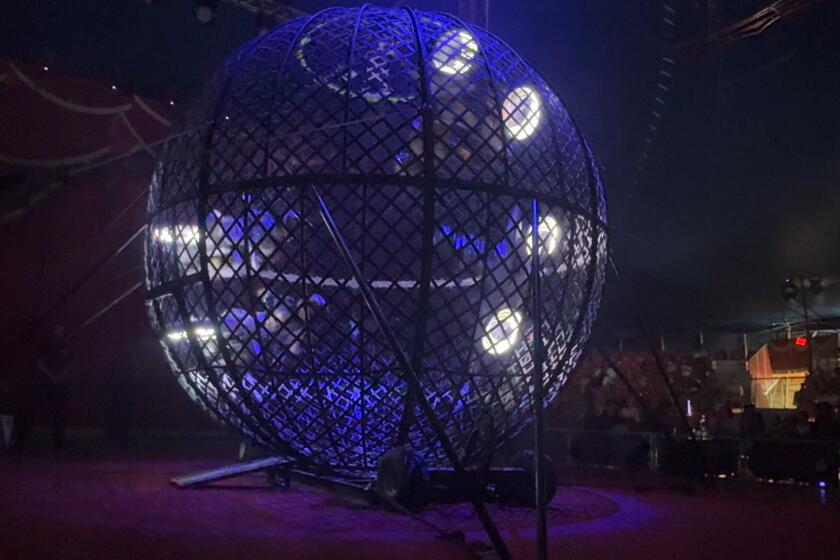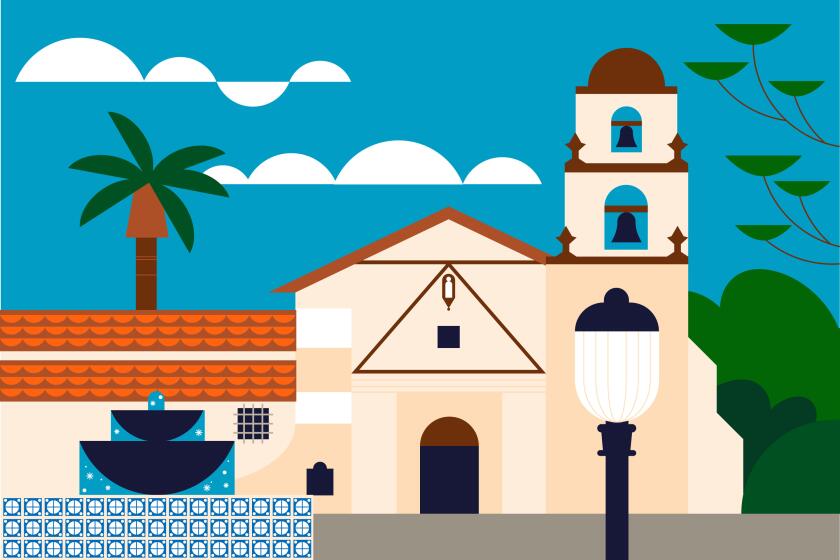Koreatown’s E-Hwa Jang restaurant salutes Syngman Rhee

Walk into E-Hwa Jang, a restaurant in the heart of Koreatown, and you are transported to another place. It isn’t just the old-school menu, the kitschy ‘70s-style decor or the hostess in colorful traditional dress. The space doubles as a museum-cum-shrine dedicated to Syngman Rhee, South Korea’s first president, who held office from 1948 to 1960.
Faded news clips adorn the walls, stacks of booklets praise Rhee’s achievements, and there’s a larger-than-life portrait of the man himself. The restaurant takes its name from the late president’s residence in South Korea. Its menu includes some of Rhee’s favorite dishes -- such as oxtail broth soup and soondubu stew, which his second wife, Francesca Donner from Austria, reportedly made from scratch for him.
The 8-month-old E-Hwa Jang is the brainchild of 69-year-old Hi Duk Lee, a pioneer developer of Koreatown in the 1970s. Lee has a mission: to spread the gospel of former President Rhee. “Dr. Rhee is one of two Korean historical figures I admire most,” he says. (The other is King Sejong, who invented the Korean alphabet in the 15th century.)
The memorabilia on the walls depict milestones in modern Korean history, from Rhee fighting for Korea’s independence from Japanese colonialism in the 1920s and Japan’s surrender in 1945 to Rhee’s 1948 proclamation of the Republic of Korea. In addition, there’s a 1987 photo of restaurant owner Lee on the summit of North Korea’s Mt. Baekdu (a symbol of reunification on the Korean peninsula), wearing nothing but his underwear and waving the South Korean flag.
E-Hwa Jang is Lee’s third restaurant and perhaps the one closest to his heart. On any given day, the restaurateur-turned-historian tends to his customers, hopping from table to table, sporting a metal badge that reads “Owner Lee.”
Lee, a distant relative of Rhee (Lee and Rhee are different ways of Romanizing the same name), dismisses the corruption and power-mongering allegations surrounding Rhee’s 12-year rule. “Korea simply wouldn’t be what it is today if it weren’t for Dr. Rhee,” he says.
In the same vein, Koreatown wouldn’t be what it is today were it not for Lee. He arrived in America in 1968 with $50 in his pocket and opened Olympic Market, one of the first Korean markets in the nascent Koreatown. Business boomed, and Lee got busy building the foundations of a vibrant community.
In 1975, Lee opened his first restaurant, Young Bin Kwan (VIP Palace), which was an instant hit. Demographics change, and the Olympic Boulevard restaurant is now La Guelaguetza serving Oaxacan food, but its blue-tiled roof and other original Korean architectural details remain intact.
At the same time, he was involved in efforts to create an annual Korean heritage festival (Korea Day) and later met with city officials to advocate for the mid- Los Angeles area to receive the “Koreatown” designation, which it did in 1982. Later that year, Lee invested his money to open a Los Angeles Police Department neighborhood center with interpreters to make it easier for non-English speakers to report crimes.
“I wanted to do something positive for society,” says the self-proclaimed “Komerican,” short for Korean American. He gives scholarships in Rhee’s honor to Korean American college students. “Dr. Rhee also groomed great leaders,” he says.
Rustic staples
ON E-HWA JANG’S glass storefront is a sign that reads “E-Hwa Jang Super Boiling Pot,” and behind the glass sit two gigantic vats Lee brought from South Korea to make the broth of his signature dish, sul lung tangsul lung tang. This hearty soup of beef brisket and thin noodles (rice optional) is topped with chopped green onions, coarse salt and spicy red pepper paste to taste.
“We boil the bones for at least 10 hours to give it that depth of flavor,” Lee says. For many Koreans, it is the quintessential comfort food when recovering from a cold or a late night out.
The menu offers rustic staples reminiscent of hole-in-the-wall joints squeezed into alleys in less developed parts of Seoul and the countryside. There’s a well-seasoned, succulent braised cod in a spicy and sweet sauce (sengsun jorim on the menu), an eclectic array of banchan, or side dishes, including pickled cucumber seasoned with red pepper flakes, sesame oil and garlic; radish and mustard greens kimchi; and pickled radish strips. Unusual side dishes include blanched parsley seasoned with salt, garlic and sesame oil; and pickled turnips usually served in Korean-style Chinese restaurants.
Other dinner table classics include soondubu stew, a sizzling, red-hot soft tofu concoction, and broiled fish such as meaty mackerel pike, silvery hairtail and salt-tinged yellow corvina -- all typical dishes you would eat at a Korean home.
The menu says patrons can “Broil Beef Gut on Your Table,” a reference to a patio coming in November where diners will be able to grill meats, including cow intestines, table-side.
When a non-Korean customer curiously eyes a scallion pancake arriving at a different table, Lee promptly sends her complimentary slices to sample. Loyalists and old-timers have been going to his restaurants for years, but today, non-Koreans account for about 1 in 3 customers, according to Lee.
“Korean food is becoming more popular among non-Koreans, especially vegetarians,” he says. For new customers, he personally demonstrates how best to mix the rice and vegetables in the healthful bibimbap, ormixed rice, dish piled with cucumbers, carrots, shiitake mushrooms, zucchini, root vegetables and a fried egg.
Ever the hands-on host, Lee offers to pick the chicken meat apart using two spatulas when a customer orders samgyetang, an aromatic, nutritious soup made from a whole young chicken stuffed with glutinous rice and slow-cooked with garlic, ginseng, dried jujubes, gingko and pine nuts.
Remember when . . .
THE RETRO decor -- paper lanterns, calligraphy written and given to Lee by former President Kim Young Sam (1993-98) and screens with traditional Korean art -- adds to the nostalgia for Korean Americans old enough to remember what South Korea looked like circa 1970s.
“Coming here gives me a little taste of where I came from,” says Romano Park, a fortysomething Korean Air employee, who, on a recent Sunday, has just cleaned up a large pot of beef gut casserole and a steamed meat platter with his colleagues. When asked about the restaurant’s homage to Rhee, Park’s dinner mates enthusiastically recite Rhee’s famous words, “United we live, divided we die!” adding that they try to honor the late president’s legacy.
That makes owner Lee proud and happy. And in case patrons like Park want to learn more about the late president, owner Lee gives out souvenir “founding father” calendars highlighting Rhee’s life.
E-Hwa Jang, 528 S. Western Ave., Los Angeles, (213) 384-5959.
More to Read
Sign up for The Wild
We’ll help you find the best places to hike, bike and run, as well as the perfect silent spots for meditation and yoga.
You may occasionally receive promotional content from the Los Angeles Times.

